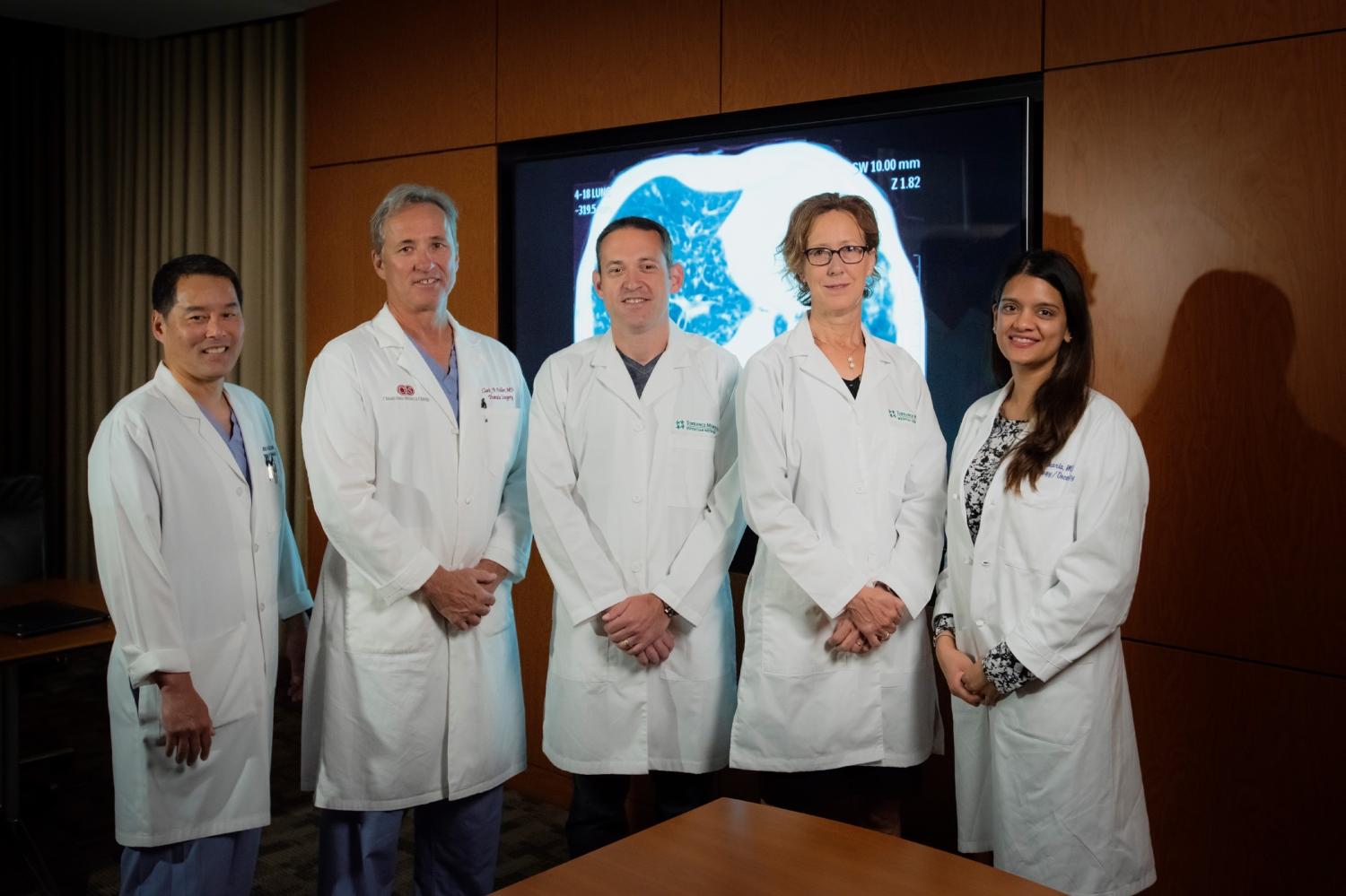
Very little about cancer can be considered positive. It’s a frightening diagnosis and a challenging journey to recovery. Torrance Memorial Hunt Cancer Institute is committed to providing the best cancer care in the South Bay. And with the new alliance with Cedars-Sinai, patients will have more access to cutting-edge technologies and clinical trials, just for starters. In a word, the partnership is changing everything. Here are just a few of the reasons Torrance Memorial is the first step on the road to recovery.
1 The Hunt Cancer Center
The Hunt Cancer Center will have one focus: to serve the patient. The Center will consolidate many of Torrance Memorial’s existing cancer treatment services—the new building, due to open in September 2019, will house nurse navigators, genetic counseling services, the Torrance Memorial team of oncology experts as well as Cedar-Sinai specialists and clinical research trials with Cedars-Sinai. Even the parking (this is Los Angeles after all) has been designed with cancer patients and their support teams in mind. “We wanted a comfortable environment,” says Heidi Assigal, vice president of business and operations for Torrance Memorial Health System. “The environment will be relaxed and open—yet private and efficient—allowing patients to feel comfortable where they really will be spending a lot of time.” This starts with the 32 chemotherapy infusion service areas. “They’ll be quiet, with internet and TV and plenty of room, while still giving staff a good visual connection and helping patients not feel shut off. I think we struck a good balance in the new center.” The key, says Assigal, will be the care clusters—groups of four so each nurse can focus on their group and patients can feel that personal attention. Even the exam rooms reflect the reality of treating cancer patients. “Some really important conversations take place there,” she says. We tried to think of everything.”
2 Doctors Leading the Fight
David Chan, MD, director of breast cancer clinical research for Torrance Memorial Physician Network, is heading up a team whose work could change how cancer is treated. “We are currently working on a clinical trial using immunotherapy that may lead to new treatment avenues for certain types of breast cancers,” says Chan. “Torrance Memorial is one of only five centers in North America selected for this potentially groundbreaking study.”
“David Chan is a rare combination of leading cancer researcher and empathetic, patient-oriented physician,” says Heidi Assigal. Chan, who will join several oncologists in the Hunt Cancer Institute, also literally wrote the book on breast cancer—and has authored 17 studies on breast cancer. Good hands, indeed.
3 New Partnership with Cedars-Sinai
Earlier this year Torrance Memorial announced a formal affiliation with Cedars-Sinai, one of the nation’s foremost academic health systems. The goal of this new affiliation is to bring the resources and expertise of Cedars-Sinai’s clinical specialties and programs to the South Bay. From oncology to neuroscience to advanced medical research and clinical trials, this partnership will expand our community’s access to the best in medical care.
In certain specialties—including all types of cancer—Cedars-Sinai physicians will partner with Torrance Memorial physician leaders to help our patients access the latest clinical trials, new treatments and advanced technology.
As our relationship with Cedars-Sinai continues to grow, we fully expect the benefits and opportunities for our patients to expand.
“At Torrance Memorial, we already have very high quality and patient experience ratings, new facilities and equipment and a great staff,” says CEO Craig Leach. “The addition of the Cedars-Sinai relationship will only strengthen our foundation as the South Bay’s premier hospital system.”
4 On-Site Genetic Counselor
Imagine learning you carry a gene mutation that puts you at higher risk of cancer or that may explain why you developed cancer. It would potentially impact not only your health situation but also those of your family members. It’s not the kind of news you’d want to receive or discuss over the phone.
That’s why the Hunt Cancer Institute has a genetic counselor on-site. An expert in both genetics and counseling, Lauren Rudichuk, MS, CGC, is right where patients need her to provide medical guidance and emotional support. “Genetic counseling is a key component of multidisciplinary care for cancer,” says Rudichuk. “And this can be difficult information for people to hear and absorb. Having someone to connect with in person can make a big difference.”
5 Nurse Navigators
Getting a diagnosis of cancer is devastating enough. But as anyone who has tackled cancer knows, it’s just the beginning. The journey toward treatment can be almost as overwhelming as the disease itself.
This is where the nurse navigator program at Torrance Memorial’s Hunt Cancer Institute steps in. Nurse navigators guide patients along the path to recovery by helping them make informed medical decisions, assisting with scheduling multiple doctors' appointments and tests, making sure they stay on track with their treatment plans, running interference on insurance issues and offering emotional support. All this is at no additional charge to patients.
The ultimate success for a patient, of course, is survival. And Torrance Memorial is uniquely equipped to lead a patient through that phase as well. Cancer survivorship coordinator Miriam Sleven, RN, MS, OCN segues patients as they complete treatment and move forward with their lives. “One of my most important roles is as a coach,” Sleven says. “I help survivors practice talking to their doctors and asking questions, so they will get the answers they need.”
Bottom line: The program is a shining beacon of guidance and hope. “We help patients not fall between the cracks,” says nurse navigator Wendy Nuval Bacerra, RN.
6 Tumor Board
One of Torrance Memorial’s cornerstones, the Tumor Board brings a crucial, multidisciplinary approach to all types of cancers. Nurse navigators, surgeons, pathologists, oncologists, radiologists and more meet weekly to address prevention, early detection, diagnosis, treatment plans and survivorship. All these experts collaborate on the best treatment plan for every stage and every possibility.
“Patients see and appreciate how comprehensive this approach is,” says Andrew Horodner, MD, chairman of Torrance Memorial’s Tumor Board, oncologist and hematologist with Torrance Memorial Physician Network. “We spend as much time as needed on each case, and our team is well coordinated and collegial. We look at everything involved, from cellular, genetic and pathology charateristics to imaging, to ensure we provide a personalized treatment plan for each and every patient."
7 Cancer Clinical Trials
A robust clinical trial program and a growing partnership with Cedars-Sinai means the physicians at Torrance Memorial are advancing the field of cancer care—and giving patients access to some of the most promising cancer treatments years before they become available to the public.
Torrance Memorial is one of only five medical centers in North America that is participating in the latest research to learn more about the role of androgen receptors in breast cancer. And the hospital is also participating in clinical trials to explore how different lung cancer treatments can be combined to increase effectiveness and improve patients’ quality of life.
“We plan to leverage our relationship with Cedars-Sinai to expand our clinical trial offerings while providing the best cancer care for our patients,” said Hugo Hool, MD, chairman of Torrance Memorial’s oncology committee, director of the Hunt Cancer Institute and oncologist and hematologist at the Torrance Memorial Physician Network.
8 TrueBeam Radiation Therapy
The very word “radiation” can be terrifying. It also can be an important treatment tool. The good news: Torrance Memorial is utilizing the latest in radiation therapy, TrueBeam, a state-of-the-art linear accelerator that helps zero in on tumors while sparing normal tissue.
“The TrueBeam has two great strengths: high precision and flexibility,” notes Thyra Endicott, MD, a radiation oncologist at the Hunt Cancer Institute. “It can be used for treating tiny tumors with very tight dose margins and highly exact setup, and it can be used to treat broader areas if the cancer has already spread to adjacent lymph nodes.”
Qinan Bao, the lead physicist working with TrueBeam, notes that it enables better treatment by targeting the tumor volume more precisely. As a result, it “gives a smaller dose to the critical organs, so the patient may experience fewer side effects.”
And because normal tissue is less likely to be damaged, higher doses of radiation can be delivered. If a patient is a good candidate for the therapy, a team of experts will develop the best course of treatment. “It’s a wonderful machine,” Endicott says, “but the people behind it are the most important variable.”
9 3-D Breast Imaging
The battle against breast cancer continues at Torrance Memorial Medical Center, and one of the best weapons today is 3-D mammography. Board-certified radiologist Patricia Sacks, MD, is medical director of the Polak Breast Diagnostic Center. “The center has always been at the cutting edge of diagnosis,” Sacks says. “For instance, our 3-D mammography is now 41% more accurate, which reduces the number of callbacks we have to do by at least 40%; those callbacks make women really nervous.”
A conventional mammogram creates a two-dimensional image of the breast from two X-ray images of each breast. Several studies have found that 3-D mammograms find more cancers than traditional 2-D mammograms and also reduce the number of false positives. And a three-year analysis published by JAMA Oncology found the benefits last over time. While 3-D imaging may soon be the standard of care, only Torrance Memorial offers it in all five of its breast centers.
For information on mammography or any of the other services offered at the Polak Breast Diagnostic Center, please call 310-517-4709.
10 Bronchoscopy
Lung cancer is more common than you think, causing more deaths from cancer than breast, prostate and colon cancer combined. While smokers have a high risk of developing lung cancer, nonsmokers can get it too.
Diagnosing lung cancer early and finding tumors when they’re still small can help improve patient outcomes, says John T. Abe, MD, a physician at Torrance Memorial Physician Network. board-certified in pulmonary and critical care medicine.
There are different types of bronchoscopy; one of the latest is electromagnetic navigation bronchoscopy (ENB), says Abe. This cutting-edge diagnostic tool, can biopsy areas of the lungs that previously could only be biopsied by performing invasive surgery and opening a patient’s chest.
“Another important diagnostic tool we use is endobronchial ultrasound,” Abe adds, “which allows us to sample mediastinal lymph nodes without surgery and assists in appropriately assigning a stage to patients with lung cancer." In addition, a lung CT scan can find tumors early, also without invasive surgery. "We treat patients as an interdisciplinary team, calling on our experts in pulmonary medicine, critical care, cardiothoracic surgery, oncology and radiation oncology to provide the best treatment for each.”
11 Liquid Biopsies
A new type of biopsy is under investigation at Torrance Memorial, and it may change the way we detect and treat cancer.
The new method is known as a liquid biopsy and it is much less invasive than a standard biopsy, which can require surgery. Instead, it analyzes DNA or other genetic material produced from tumor cells circulating in the blood.
In partnership with liquid biopsy companies, three clinical trials are currently underway at the Hunt Cancer Institute. A national multicenter feasibility trial is developing a DNA/RNA blood test to diagnose breast cancer in its early stages. Another trial aims to better diagnose lung cancer so patients will need fewer scans and biopsies.
Detection is just one of the hopes for liquid biopsies. A third clinical trial is identifying specific genetic markers or mutations that can help physicians choose the most appropriate course of care. Though all studies are in the development phase, the promise of liquid biopsies is great, and Torrance Memorial is at the forefront of this exciting technology.
12 Team Collaboration
Sometimes one plus one equals three. That’s what thoracic surgeon Clark Fuller, MD, says of the partnership between Torrance Memorial and Cedars-Sinai. “It’s a blending that truly benefits patients,” he explains.
Take Fuller himself. A full-time faculty member at Cedars-Sinai, his current collaboration with Torrance Memorial andCedars-Sinai was a good model for how the two teams could work together. His specialty is lung surgery, which traditionally requires a large incision—but the minimally invasive techniques he pioneered reduce both the incision and the recovery time. Hospital stays decrease from an average of nine days to two, and recovery times are measured in weeks not months. Only 40% of thoracic surgery performed in the United States is minimally invasive, Fuller says, and Cedars-Sinai is “the epicenter of that certainly in the Western hemisphere, if not the world.”
World-class care relies on an interdisciplinary approach, bringing surgeons, oncologists and others together to take on and defeat cancer. Torrance Memorial, Cedars-Sinai and doctors like Fuller will take that teamwork to new heights.
13 Cancer Support Groups
“The first thing people say [after diagnosis] is ‘Why me?’” says Kristel Quinto, the new psychosocial coordinator of oncology services at Torrance Memorial. She’s charged with starting new groups to support the existing women’s, men’s, head and neck, lung cancer, breast reconstruction and mastectomy groups.
“When you’re in a peer support group, you don’t feel so alone,” Quinto asserts. “You might still feel overwhelmed, but there’s nothing like knowing you can talk to people going through the same thing. The groups provide a safe environment where everyone embraces you with love and kindness.”
Quinto says the gatherings are very positive and are led by expert facilitators—some of whom are cancer survivors themselves—who have a special passion for advocating and supporting the members. “Our goal as a team is to make sure that our patients and their families receive a balance of support in achieving physical, emotional, social and spiritual wellness for better health outcomes.” All the groups deal with a wide variety of types of cancer. For more, search support groups at TorranceMemorial.org
14 Teaming Up to Beat Breast Cancer
Torrance Memorial’s entire cancer care team—which includes male and female breast cancer specialists—is committed to delivering leading-edge breast cancer care in a warm, compassionate and supportive environment. But some women who have breast cancer may feel more comfortable or supported discussing certain health issues with a female health care provider.
That’s why our breast cancer patients have the option to choose female health care providers—including a radiologist, medical oncologist, radiation oncologist, breast cancer surgeon, plastic reconstructive surgeon and nurse navigator—for all aspects of their breast cancer care.
“A female breast cancer patient may feel more comfortable expressing concerns or talking about sensitive issues with a female health care provider,” said Vanessa Dickey, MD, an oncology hematology specialist at Torrance Memorial Physician Network. “If we can cut through that embarrassment, it will make the patient feel more at ease and give them one less thing to worry about.”
15 The da Vinci Robot
R2-D2 in the operating room? Well, almost. Under the watchful eye—and hands—of skilled surgeons, major operations become minimally invasive procedures thanks to a robot. The da Vinci Surgical System offers surgeons increased precision compared to other types of surgery, and patients experience less pain, decreased blood loss and shorter recuperation time.
Torrance Memorial began using the system in 2006 and has a skilled robotic surgery team led by Hoa Van, RN, BSN. Robotic surgery greatly improves the experience of cancer patients, says surgeon Ramin Mirhashemi, MD.
"We are at the cutting edge at Torrance Memorial Medical Center, there is no doubt in my mind," he says.
16 Woman to Woman Program
Since 1993 the Woman to Woman Image Enhancement program has helped hundreds of female cancer patients feel attractive. Losing hair due to cancer treatment can trigger depression. This free service, which provides assistance with scarves, hats, wig-liners and other resources, bolsters women’s confidence, says Miriam Sleven, RN, MS, OCN, cancer survivorship coordinator at Torrance Memorial's Cancer Resource Center. For an appointment, please call 310-517-4660.
17 Cancer Survivors Day
“It’s a celebration of survivors and their loved ones, an acknowledgement of the team that got them through. It’s a celebration of success,” Miriam E. Sleven, RN, MS, OCN enthuses about National Cancer Survivors Day at Torrance Memorial, observed annually with a dinner, a banner to sign and speakers who include doctors and patients telling their stories. “Dinner is served by our Luminaries and Novas volunteers. One year we had a patient who juggled while he spoke; another we had a jokologist,” Sleven continues. “From my perspective it’s a great, uplifting event, and I know the patients, families and staff who attend feel the same. It’s a beautiful celebration.”
18 There’s No Place Like Home: Torrance Memorial Home Health
Torrance Memorial has a reputation as an excellent hospital. But the medical center provides top-notch services beyond its walls. Case in point: its award-winning home care-providing agency. The truth is, I don’t know how we would have made it through this past year without Torrance Memorial Home Health. My 86-year-old dad, Thomas Farrell, has been participating in a clinical trial for acute myeloid leukemia—a disease with a very dire prognosis at his age. The trial put him in remission, but he has needed twice weekly blood draws to monitor his counts and home hydration to help him recover from chemotherapy treatments.
This award-winning department, headed by Theresa Ferry, RN, BSN, MBA, CHCA, supplies nurses and other staff who make visits to patients’ homes to provide services such as blood draws and infusions. “We’re focused on a high bar for quality,” Ferry says.
The amazing nurses also helped us organize his medications. Their skill, compassion and professionalism helped us get through a few really rough patches. They truly are angels from heaven.






